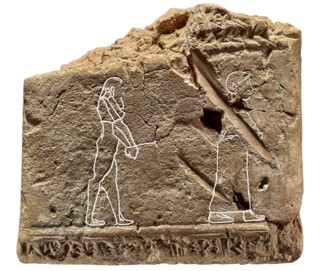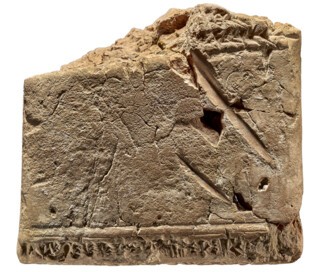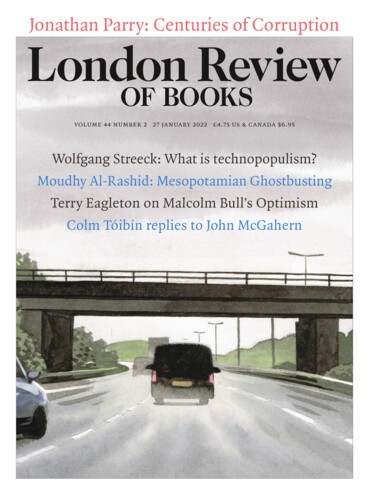At the back of the British Museum is a cavernous room lined with hundreds of cased wooden drawers supported by a central architrave. Each drawer contains tens of glass-topped boxes of various sizes with neat, typewritten labels. The boxes contain clay tablets from ancient Mesopotamia, around 130,000 of them, inscribed in cuneiform, many broken and eroded. An agricultural boom at the end of the fourth millennium BCE led the Sumerians to create the first written records, in order to help them keep track of various commodities. These early signs, traced in wet clay with the sharpened end of a reed stylus, looked a lot like the things they represented: a bowl for food or rations, a jug for beer and so on. Over time, the scribes realised that it was quicker to impress than to incise signs into clay, and the resulting script, cuneiform, gets its English name from the characteristic wedges (cuneus in Latin).
The earliest written recipes, laundry receipts, peace treaties, poetry, representations of pi and lullabies are inscribed in cuneiform. Six thousand years ago, people living in present-day Iraq washed their clothes and did maths and shared songs and baked bread. They also saw ghosts. In his new book, The First Ghosts, Irving Finkel, the curator in charge of the BM’s clay tablets (and the reason I dropped law to study cuneiform), discusses what these and other artefacts excavated from Mesopotamia tell us about supernatural apparitions and the ways they populated everyday life. The clay tablets, he writes, preserve ‘abundant and surprising details’ in the form of omens, spells, myths, royal propaganda and letters, ‘almost as if they anticipated our interest’.
Burial sites from across the ancient world attest to what Finkel describes as ‘the deep-seated conception that some part of a person does not vanish for ever’. The first recorded use of a word to describe a spirit that is separate from, and survives, the human body is a tablet dated to the early third millennium BCE, which is inscribed with the cuneiform character for the Sumerian word for ‘ghost’, gidim (although it originated as the script for Sumerian, cuneiform was adapted for a number of other ancient languages, including Akkadian and Hittite). Inhabitants of Mesopotamia were usually interred after death. The Royal Cemetery at Ur, uncovered during excavations in the 1920s, housed sixteen royal tombs that date from roughly the same period as the gidim tablet. The aristocracy of Ur entered the afterlife with crowns, chariots, helmets, harps and daggers. Some of them left this world with an entourage: archaeologists discovered what they described as a ‘great death pit’ adjacent to one tomb, containing the remains of 74 people, including adolescents. One skull from the pit that underwent a CT scan was identified as that of a woman in her late teens or early twenties: the last thing she felt would have been the blunt force of something like a battle-axe.
Not every Mesopotamian was buried in such style. Graves have also been discovered beneath and within the walls of family homes, allowing the deceased to be fed and watered by their surviving relatives (ideally by the eldest son), who were also required to recite their names regularly. Sometimes people buried their relatives in coffins shaped like bronze bathtubs, or in large jars. Others wrapped the corpse in reed matting or covered it with broken pieces of pottery before burying it in a pit. Even unborn babies, some barely beyond twenty weeks of gestation, were given a final resting place. Finkel cites a Sumerian poem about Gilgamesh: ‘Did you see my little stillborn children who never knew existence?’ Gilgamesh asks the ghost of his companion, Enkidu. ‘I saw them,’ Enkidu replies. ‘They play at a table of gold and silver, laden with honey and ghee.’
Those who went unhappily to their graves or who remained unburied, as well as those whose tombs were untended (or insufficiently tended), became restless ghosts. The spirits that rose from the dead were as varied as their living counterparts: there were ghosts of the very young, of women who died in childbirth and those who died as virgins, of wet nurses, soldiers, slaves. Sometimes they were described according to the way they met their end – by drowning in a river, burning to death, falling off a roof or being slain in war. They retained the characters of the people they had once been, from mild-mannered to malicious. Like more recent depictions of ghosts, the Mesopotamian accounts make clear just how unpleasant these spirits could be. A 99-line spell, which belongs to a much larger work on expelling demons, describes ‘exactly what it was like to be visited by an unknown, unidentified ghost of the roaming, malicious hooligan type’. These ghosts ‘flicker like flame’ and ‘flash like lightning’, they cross the thresholds of houses and descend over the rooftops. They frighten, snarl at and otherwise torment the ‘sick person’. They hide in a house’s holes and crevices, they slither, they stalk people, they roam the streets and steppe.
The spirits of the restless dead also caused medical havoc. They formed part of a complex explanatory system for illness, which included deities, demons and even witchcraft alongside causes we would still recognise – a snake bite or the sun’s heat. Some ghosts entered the body through the ear. The word for ‘ghost’ could be written in several ways that exploited the many meanings layered onto each cuneiform sign. As Finkel writes, one sign combined the signs for ‘open’ and ‘ear’, giving a literal reading of ‘ear-opener’. Ghosts, therefore, could cause roaring or ringing ears as well as all manner of medical misery, from madness and headaches to flatulence, fever, chills and depression. Some cuneiform texts that describe ghost-induced illness detail the way the now ghost died, and sometimes the manner of death corresponds to the symptoms the ghost causes: the ghost of a person who drowned, for example, caused shortness of breath in the haunted person, ‘like one who has just come up from the water’.
A rich tradition of ghostbusting emerged in response to the many troubles caused by ghosts in ancient Mesopotamia. Those who could afford it turned to scholars known as the ashipu, whose accepted English translation of ‘exorcist’ doesn’t quite capture their professional domain. Usually men (though there are sporadic references to women exorcists, for instance in the Maqlû series of incantations against witchcraft), these scholars spent years mastering medical knowledge and treatment, including what we might call ‘magical’ remedies. Medicine in Ancient Assur by the Assyriologist Troels Pank Arbøll follows the career of one such exorcist, Kisir-Ashur.* By piecing together more than seventy texts found in a private library in the city of Ashur, Arbøll has mapped out Kisir-Ashur’s training, which included anatomy, diagnostics, paediatrics, veterinary medicine and magic. As a trainee, with the help of his father, he learned practical skills that ranged from the use of bandages and emetics to spells and rituals. In one instruction manual, written in the summer of 658 BCE, Kisir-Ashur describes how to treat a patient suffering from ghost-induced confusion. After sweeping the ground and sprinkling it with purified water, setting up an incense burner and pouring a libation of beer, the exorcist must make a figurine of the confusion-causing ghost from clay, tallow and wax, which the patient then holds up to the sun god while reciting a long incantation.
The medical and magical instruments at the exorcists’ disposal were as varied as their patients’ ailments. Someone troubled by visions of dead people might be told to wear a leather pouch filled with various plants and a soiled rag, or other noxious substances such as sulphur or fish oil (these were also useful in repelling unwanted living visitors). Another ritual calls for three libations of donkey urine; Finkel explains that ‘the thirsty ghost – for ghosts were always thirsty – might take it for a refreshing beer and receive a punitive shock.’ Spells exploit connections not immediately obvious to a modern reader: some of them have abracadabra-like strings of words and syllables whose original meaning might well have been forgotten but whose magical applications remained powerful. Some of these spells involve necromancy, to which Finkel devotes a chapter.
Some ghosts formed an intense connection with their victims, requiring the exorcist to create a substitute companion. Around ten lines of cuneiform survive on one side of a broken clay tablet from the fourth century BCE. They were written by a Babylonian scribe called Marduk-apla-iddin as part of a manual describing how to get rid of a ghost so persistent it resisted other methods of exorcism. The reverse of the tablet appears to be blank, but under the right light the outlines of two figures appear. It is incredibly rare to find drawings on tablets from ancient Mesopotamia: only a handful have been discovered so far. In this image, a man with a long beard holds his shackled hands in front of him, attached to a rope. On the right, a woman in a smock holds the other end of the rope. The instructions tell us that she has been created as a companion to entice the obstinate ghost into the underworld. Finkel reckons that the figure on the left is ‘the oldest drawing of a ghost in the history of the world’.
Students of Akkadian today often read a Babylonian narrative about the journey of Ishtar, goddess of love and war, through seven gates into the ‘Land-of-No-Return’. Ishtar’s descent into that ‘gloomy house’, whose inhabitants live in darkness, eat dust and clay, and wear feathers for clothes, gives us a glimpse of the horrors imagined by Mesopotamians for the afterlife. Another underworld account comes from a nightmare reported by an Assyrian prince called Kummaya, and relates how he was held captive in the ‘House of Death’, which was populated with ‘top-rank underworld gods and demons’. Here he met seventeen embodiments of evil in the form of hybrid demons and ghosts, and a personification of Death with the head of a dragon. It’s not surprising that the bearded Babylonian ghost didn’t want to make the one-way journey through the seven gates.


Conceptions of the afterlife were not uniformly bleak. Ancient Mesopotamians were buried with bowls, saucers, bottles, bracelets, beads and even toys. Wherever they were going, the dead, it seemed, could still eat and drink and dress and play. But many of them hung around the living. I imagine ghosts in much the same way the Mesopotamians did. They should look and act like the people they once were, but they represent something beyond the restlessness of the dead, giving shape to what is lost, difficult or unresolved.
Send Letters To:
The Editor
London Review of Books,
28 Little Russell Street
London, WC1A 2HN
letters@lrb.co.uk
Please include name, address, and a telephone number.

